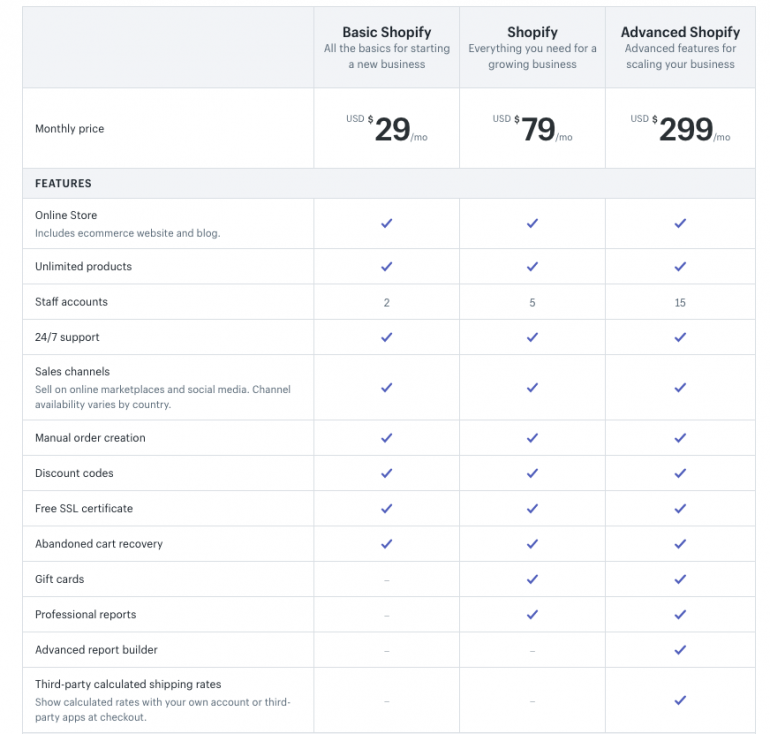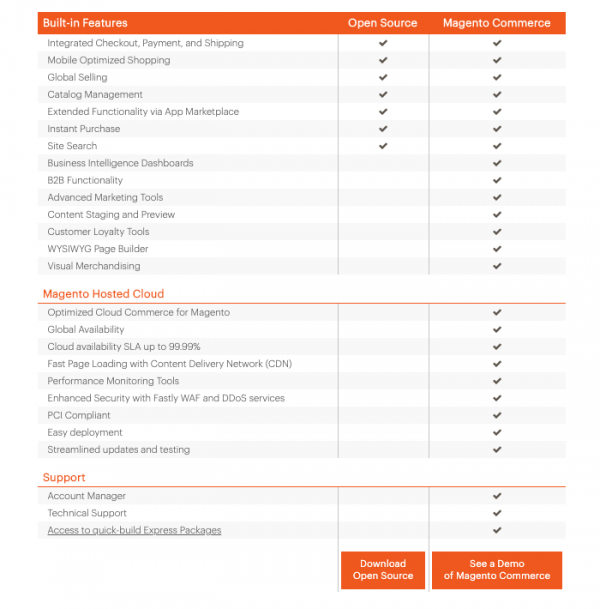Magento vs. Shopify: Which Is Right for Your Business?
We pit Magento vs. Shopify, two e-commerce giants, against each other in terms of pricing, features and more.
Many, or all, of the products featured on this page are from our advertising partners who compensate us when you take certain actions on our website or click to take an action on their website. However, this does not influence our evaluations. Our opinions are our own. Here is a list of our partners and here's how we make money.
Table of Contents
Table of Contents
When you’re starting an e-commerce business, choosing a platform to build and operate your store is one of the most important decisions you’re going to make. In researching the many options out there, you may see these names pop up again and again: Magento and Shopify.
Shopify offers you a fully-hosted platform with a variety of capabilities, set pricing and is known for its user-friendliness. Magento, on the other hand, gives you the choice between Commerce and Open Source, both praised for their vast feature sets and customization abilities. This guide will help you decide which option might be right for your business.
advertisement

Shopify Ecommerce
$29
Basic Plan. Grow & Advanced Plans Available.
on Shopify's website
Features
One of the most significant factors that play a role in deciding which e-commerce platform is right for you is the features that the platform offers.
Shopify
One of the reasons that Shopify is so popular, in fact, is because of the breadth of features that are included in its platform. In fact, the included features are one of the factors that distinguish it from other similar software, like when comparing Shopify to BigCommerce, for example. Some of Shopify’s unique capabilities include:
Shopify Payments: Shopify has its own payment processor included with its platform; if you use Shopify Payments, there are no additional transaction fees.
Abandoned checkout recovery: Automatically send an email to users with a link to their abandoned card encouraging them to complete their purchase
Blogging platform: Not only do you have a store website, but also a blog to publish articles and encourage discussion from customers.
Automatic taxes: Shopify automatically handles country and state tax rates.
Mobile app: Shopify’s customizable mobile app lets you manage your orders, products, staff and customers while you’re on the go.
Marketing: Shopify has advanced marketing capabilities like SEO optimization, loyalty programs, discounts, gift cards, social media integration and more.
Shopify App Store: The Shopify App Store has over 7,000 apps (everything from dropshipping to email marketing) that you can download to extend the functionality of your store.
Customer support: Shopify offers its users 24/7 support, as well as access to its help center, discussion forums and e-commerce university.
The exact features that are included with Shopify ultimately depend on your subscription plan, which you’ll see broken down in the photo below.

Source: Shopify
Magento
Similar to Shopify, Magento is known for the impressive list of features included with its platform. Here are a few highlights:
Instant checkout: In addition to your general shopping cart capabilities, Magento offers an instant checkout, which allows users to quickly and easily checkout on one page.
Site management: Magento has advanced site-management abilities, allowing you to control multiple websites and stores from one admin, as well as create, preview and schedule content updates.
Payment processing: Magento works with common payment gateways like PayPal and Braintree and has integrations with over 300 more, including international gateways.
Reporting: Magento’s platform includes 100 predefined reports, nine reporting dashboards, as well as the ability for you to create and edit your own reports.
Customer development: Magento gives you numerous ways to engage and support your customers like guest or login checkout, email marketing campaigns, coupons, promotions, product wishlists and a gift wrapping option.
International commerce: In addition to working with international payment gateways, Magento allows you to manage multiple country sites from the same store or environment. With Magento, you can also support multiple currencies, languages and tax rates (including EU fixed product taxes).
Add-ons: The Magento Marketplace offers over 4,500 different add-ons and extensions that can be downloaded to improve your store functionality.
Just as the capabilities differ between Shopify’s subscription, however, the same is true for Magento Commerce vs. Magento Open Source. The chart below shows some of the main differences between Magento’s two offerings. As you’ll see, Magento Commerce offers many more included features.

Source: Magento
However, since Magento Open Source, is an open-source platform, you do have a unique ability to customize your store and make your e-commerce business stand out. Although Open Source may not include some of the features that Magento Commerce has, you can work with a developer to add extensions and integrations that will improve your capabilities.
Pricing
While both Magento and Shopify have extensive feature lists, their pricing is very different.
Shopify operates on a subscription basis, which you can do month to month, annually or biennially. Shopify also offers a free three-day trial, no credit card required. Shopify’s most basic plan is Shopify Lite, which costs $15 per month. This plan, however, does not give you the ability to create an online store — instead, you can sell via an existing website or Facebook page.
Shopify’s next plan is Basic Shopify, which costs $39 per month plus a 2.9% plus 30 cents fee on all online credit card purchases. For this plan, as well as the remaining three, Shopify charges an extra 2% fee if you use a payment provider other than Shopify Payments. The next two plans are Shopify and Advanced Shopify, which cost $105 per month and $399 per month, respectively. The credit card purchase fee is 2.6% plus 30 cents for the Shopify plan and 2.4% plus 30 cents for the Advanced Shopify plan. The final plan Shopify offers is called Shopify Plus and is designed specifically for high-volume merchants and large businesses. This plan is priced based on your business’s specific needs, and you have to contact Shopify directly for a quote.
Shopify has its pricing information readily available on its website, however, the same cannot be said of Magento. Magento’s website does not offer any pricing specifics on Magento Commerce, instead, you have to contact its sales team for a quote based on your business. The website does give you the opportunity to sign up for a free demo, but you have to submit your information to the Magento team to do so.
Magento Open Source is free to download. However, although the download is free, there are other additional costs associated with this open-source platform. You’ll have to find and pay for your own web hosting, security, as well as any development work that’s needed to develop and launch your store. Furthermore, there will be a cost for you to accept payments online, which will vary depending on the gateway you choose.
Where Shopify wins
Both Magento and Shopify have a lot to offer. However, there are certain areas where Shopify stands out:
Usability
When it comes down to it, one of the reasons that Shopify is a top e-commerce platform is its usability. Shopify’s platform is clean, intuitive and easy to use whether you’re a beginner or have more technical knowledge. With Shopify’s theme offerings and drag-and-drop builder, you can design your store quickly and it’s not too difficult to do so. At the end of the day, Shopify is incredibly user-friendly and this is one of the top reasons that customers like the platform.
Despite the vast array of features included with Magento, it is not particularly user-friendly, especially when compared to Shopify. Magento Open Source is especially difficult, as it requires advanced development abilities and knowledge to set up. Although Magento Commerce is a little easier, the sheer amount of capabilities makes the interface more complicated and therefore difficult to get your store up and running.
Pricing
Although it can be said that costs for Shopify can extend past its actual price structure (taking into account themes, shipping services, add-ons), due to Magento’s lack of transparent pricing for its Commerce offering, we have to conclude that Shopify is better here. When you consider signing up for Shopify, you have a starting point for what setting up your store will cost (and what it would cost any other business to run their store with Shopify) and therefore can budget your spend accordingly. Additionally, if you compare Shopify’s subscription fee to other similar platforms, like Volusion, you can see that it’s pretty competitive. With Magento Commerce, on the other hand, you have no starting point for pricing and you have no way of knowing, after talking to its sales team, if you’re actually getting a fair price.
Furthermore, although the “free” Open Source option of Magento may seem appealing, you may actually end up paying more than you would with an alternate platform. Between web hosting, security and especially development costs, Magento Open Source could end up being more of an expensive (and time-consuming) option than you would think.
Where Magento wins
Although Shopify offers you transparent pricing and user-friendliness that Magento does not, Magento wins out in the ways you can customize and develop the capabilities of your e-commerce store.
Features
Magento’s list of features seems to be incomparable to any other e-commerce platform out there — including Shopify. More than likely if you’re looking for your e-commerce store to operate a certain way, Magento will allow you to do it. In particular, Magento’s instant cart checkout, content preview and international commerce functionalities are especially impressive. Although Shopify too has a broad feature set, Magento Commerce simply offers more.
Add-ons and customization
One of the other big pros of Magento is, continuing off of its feature list, if the platform doesn’t have something you’re looking for, you have the ability to add it. The apps and integrations available in the Magento Marketplace are nearly double what is offered in the Shopify App Store. The variety of these integrations allows you to truly customize your store and extend the functionality to what you need to operate your business. Additionally, many of the integrations included in the Marketplace are “Magento Partners,” who work with Magento users to enhance their store capabilities.
Furthermore, although not right for all businesses, Magento’s Open Source option gives you a completely unique way to create and customize your store. If you want the freedom and have the resources to develop your store with an open-source platform, Magento does give you that ability where other e-commerce platform offerings don’t.
Reviews
Customer reviews of Shopify are generally positive, with users highlighting just how easy it is to get set up and start selling using the platform, especially for beginners. Many users write that Shopify fulfills their e-commerce needs and gives them the ability to grow their business. The most consistent Shopify con that users mention is the payment processing fee. Since competitors like Volusion and BigCommerce don’t charge this fee, this seems to be a valid complaint.
For Magento, on the other hand, the user reviews for both Commerce and Open Source are wholly mixed. In terms of positives, customers frequently mention Magento’s customization abilities, especially with the Open Source platform. Users also highlight the vast features Magento offers. As for the negatives, users focus on the difficulty of using the platform and the time, effort and resources it takes to get your store set up, as well as to train employees to use it. Many users also mention the cost of Magento as a negative, despite Open Source being free to download.
A version of this article was first published on Fundera, a subsidiary of NerdWallet.
